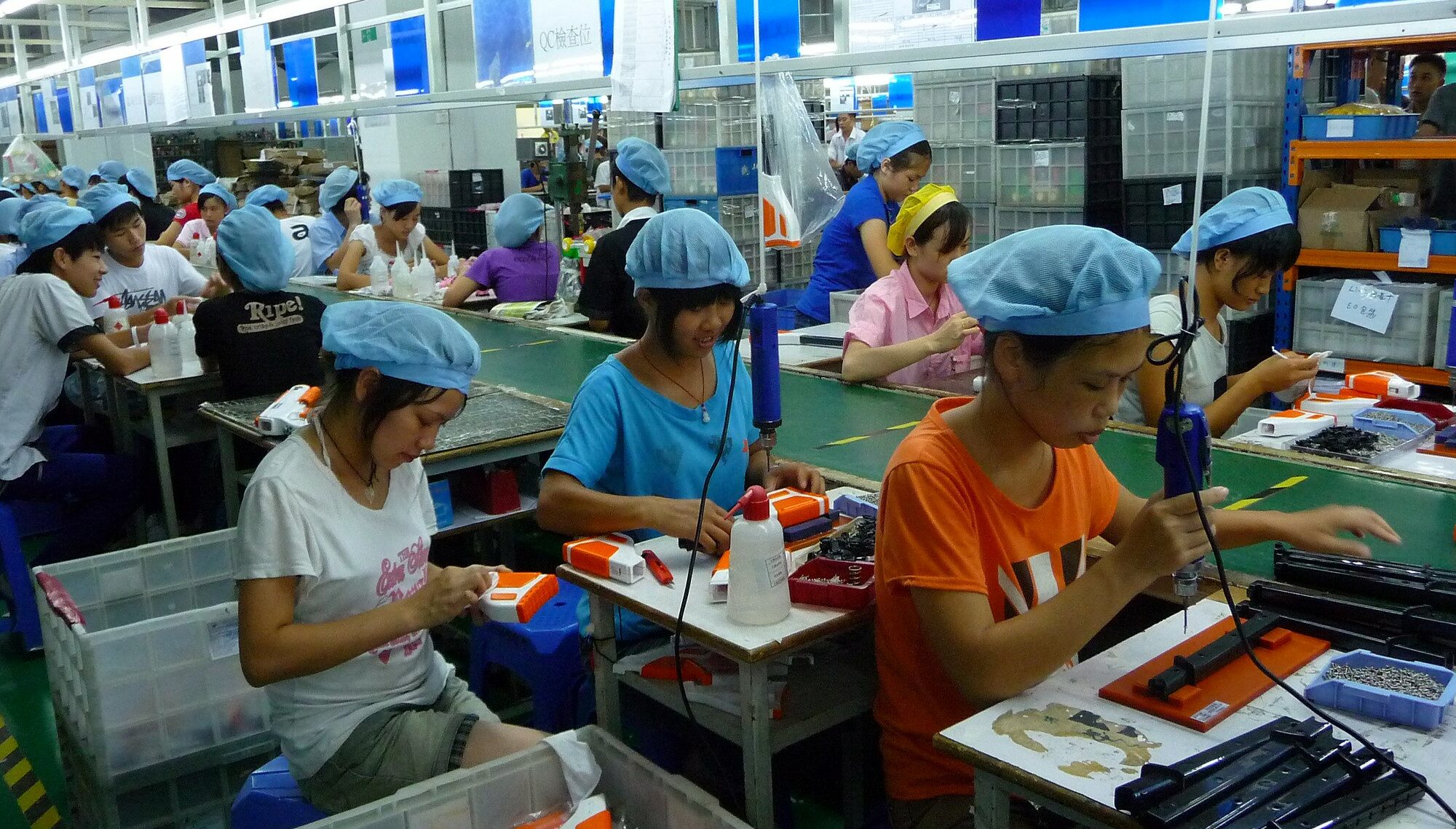By Intan Suwandi
Lockdowns and shutdowns due to the COVID-19 pandemic led to what is being referred to as the “first global supply chain crisis.” The supply chain disruption has made havoc since the beginning of the pandemic, with more than 90 percent of the 1000 Fortune multinational corporations having a tier-one or tier-two supplier affected by the virus in February 2020. By mid-April 2020, 81 percent of global manufacturing firms were experiencing supply shortages. Also in the same year, hundreds of US companies reported that their suppliers only operated at an average of 50 percent capacity, which resulted in longer final product lead times and a negative impact between 5.6 to 15 percent on their revenues. Although recent reports indicate that the situation has become less severe, many analysts still think that the “supply chain nightmare” is far from over, and it is predicted that supply chain disruptions will continue until late 2022.
Writing for Foreign Policy in 2020, some “global thinkers” argue that such supply chain disruptions are clearly breaking a system that had previously worked so well. For example, in the words of the director and chief executive of the think tank Chatham House, Robin Niblett, COVID-19 is a threat to the idea of “mutually beneficial globalization that defined the early 21st century”, and he therefore insists that we have to find a way to “protect the shared gains from global economic integration” if we do not want to lose all we have built and achieved.
There are two questions we can ask in response to an argument like this: (1) is it true that the globalization that has “defined the early 21st century” has resulted in an economic integration whose gains are shared by everyone involved—both in the Global South and in the Global North?, and (2) is COVID-19 the main cause of the global supply chain crisis, or is it merely a trigger—a factor that can bring down a tower whose foundation is already so vulnerable?
My answer to the first question is, “No,” as I explain in my book Value Chains: The New Economic Imperialism. Let us talk about the “new globalization,” centered on the globalization of production processes, that started in the late 1970s and early 1980s, where multinational corporations relocated their production abroad, especially to the Global South. Through processes such as direct foreign investments and, increasingly, arm’s length contracts, multinationals headquartered in the Global North engage in outsourced production to offshore suppliers, as well as in financialization. The World Bank estimates that between 2010 to 2014 alone, the growth rate of arm’s length trading (6.6 percent) exceeded the growth rate of the world economy (4.4 percent). Examples are not only from companies like Apple or Nike, whose products, including their intermediate parts, are entirely or almost entirely produced in the South, but also from companies that traditionally operated through their own subsidiaries when it comes to overseas production, such as automobile companies like Volkswagen or General Motors, who now outsource their production through arm’s length contracts, involving vast production networks in many countries. In the business circle, this is related to what is often referred to as the global labor arbitrage, or the substitution of higher-paid labor with lower-paid labor globally—a phenomenon that is often claimed to be an “urgent survival tactic” for corporations, where they search for the means to lower their production costs, partly to compensate for their inability to engage in price cutting due to monopoly capitalism. But the main goal for capital is to pursue higher profits, and this goal can be achieved by taking advantage of enormous differences in unit labor costs on the global level, enabled by the fact that capital can move relatively more freely compared to labor, which is still largely restricted by regulations such as immigration policies.
With this phenomenon, global commodity chains have become more complex, with each multinational corporation having thousands if not millions of suppliers across the globe, while the majority of the production processes take place in the South, making the South as home to a large and growing population of the world’s industrial workforce. This complexity has been highlighted by mainstream global commodity chains/global value chains scholars to argue that such a decentralization of production networks also leads to a decentralization of power. Less powerful firms in non-advanced countries can “upgrade” their positions, and this in turn leads to growth for said countries.
Has the “new globalization” really brought a decentralization of power?
But critical and radical scholars have pointed out that the “new globalization” is just another form of capitalist imperialism, and that imperialism has accompanied the development of capitalism since the very beginning. It is not true that the new structure of globalized production has led to a decentralization of power, regardless of changes that have happened throughout the decades. Capitalist imperialism—a system of an unequal, hierarchical world economy, dominated by giant oligopolies and a handful of states in the imperial core—as Harry Magdoff argues, is characterized by the process whereby the dominated areas, that is, the South, are transformed, adapted, and manipulated to serve the imperatives of capital accumulation in the center. While overall market relations in the emerging economy are also transformed, the firm-level transformations are often parachuted in with no real organic relation to, or logic stemming from, the emerging economy, and are just as easily dismantled and removed. This, then, creates an illusion of development and advanced production in these countries, which nonetheless remain in a dependent condition.
On the firm level, far from representing a decentralization of control over production, the “dispersed” networks associated with arm’s length production are ultimately governed by the centralized financial headquarters of the giant corporations they service, which retain monopolies over information technology and markets and appropriate the larger portion of the value added. As Bennett Harrison writes in Lean and Mean, “decentralization of production does not imply the end of unequal economic power among firms—let alone the different classes of workers who are employed in different segments of this network.” In my case studies of two Indonesian suppliers, also as a part of my book, I found that even through arm’s length contracts, multinationals still control much of what happens within their chains, either directly through their subsidiaries in the same country as the suppliers, or indirectly through a variety of bureaucratic procedures and the processes involved in “flexible production.” The point is that multinationals seek to externalize costs by, for example, putting responsibility on their suppliers to deal with various risks, such as missed forecasts caused by fluctuating market demands, and give these suppliers the burden of managing the resulting waste, both in terms of products and labor.
In the end, it is workers at the point of production—in this case, on the factory floor—who bear the utmost burden. Whenever production processes are disrupted, whenever there are pressures to cut production costs and to increase productivity from multinational clients, it is very likely that these suppliers will apply management practices that tighten control mechanisms on workers. Because without their labor, there are no commodities. In short, such a “globalization” does not benefit everyone involved. The opposite is true: it has led to increasing forms of global inequalities and deepened a divide between peoples in the Global South and the Global North.
The pandemic was only a trigger for the disruption of an inherently fragile system
Not only is this global system unequal, it is also highly vulnerable. And this leads to my answer to the second question: The COVID-19 pandemic is merely a trigger that led the global supply chains disruptions. The system that governs these chains was already fragile to begin with. Two points can be emphasized: first, as hinted above, multinational corporations are enforcing flexible systems of production where they, among other things, impose just-in-time production and shorter lead times, expecting their suppliers to produce and deliver products with high flexibility in their ability to fulfill fluctuating demands, and hence bear the burden of waste and other costs associated with this flexibility. Second, this search for greater flexibility is based on the logic of capital accumulation and the search for higher profits. In this context, as explained previously, multinationals search for low unit labor costs, where China has been one of the main destinations, along with other Global South countries such as India, Indonesia, and Mexico. Thus, since China has become “the central manufacturing hub of many global business operations”—where about 20% of “global trade in manufacturing intermediate products” is originated, any disruption of China’s output has vast consequences across the globe.
What is “resilient” from capital’s perspective?
Global capital has been responding in various ways to the supply chain crisis. Some argue that corporations are now forced to “trade off efficiency for redundancy” and see a fall in (near-term) profitability for the sake of supply-chain stability and of making the whole system more “resilient.” Ironically, however, what capital means by a “resilient” supply-chain is a system that is even more flexible and agile, with an emphasis on reconfiguring firms’ relationships with their suppliers, such as increasing their effort to gain the status of preferred customers or closely monitoring critical suppliers that have the biggest impact on these companies’ profit margins. Big corporations can afford to focus on increasing their inventory of critical products, components, and materials—a practice that can be aptly called “hoarding.” Further, the inequalities resulting from the current globalized production will only be exacerbated if corporations, as part of their mitigation strategies, increase automation and digitalization—a plan that has been suggested by many within business circles, although others have voiced skepticism towards this idea. Even though firms are commonly unwilling to apply mechanization due to its high costs, analysts still recognize that “robots do not catch a virus, and do not have mortgages to pay when they are furloughed or laid off.”
And perhaps not surprisingly, available reports show that there have not been any fundamental changes in corporate strategies when dealing with supply chain disruptions, despite the many plans that some corporations pledged to enact in the beginning of the pandemic, including the desire to regionalize supply networks or nearshoring.
But the real question here is whether restructuring the global production system will lead to significant changes in terms of power relations within global commodity chains. Current patterns suggest that, to a large extent, the same dynamic will remain; as long as the capitalist logic of accumulation is still deeply ingrained within the structure of our global commodity chains. Simply moving some nodes from one location to another will not significantly alter the existing power relations. Just as in other crises, such as the 2008 global financial crisis, producer countries in global commodity chains, especially in “non-BRIC emerging economies,” are usually racing to the bottom—often resorting to detrimental means such as “wage dumping and violations of workplace standards” to prevent foreign investments from fleeing, further enhancing the exploitation of local labor. Thus, if changes are to come, they need to be changes that significantly move away from the “business-as-usual” practices where everything is catered to the interests of global capital.
Note: This article gives the views of the author, not the position of the EADI Debating Development Blog or the European Association of Development Research and Training Institutes.
This post is adapted from two sources: (a) an article co-authored with John Bellamy Foster, “COVID-19 and Imperial Value,” published July 2022 in International Critical Thought, and (b) the author’s book Value Chains: The New Economic Imperialism (Monthly Review Press, 2019).
Intan Suwandi is an assistant professor of sociology at Illinois State University, USA. Her research topics include economic imperialism and global commodity chains. Her current project examines how global supply chain disruptions affect countries in the Global South. Her research has also been featured in our podcast on hierarchies in global value chains (episode 3)
Image: Chris under a creative commons licence on Flickr

